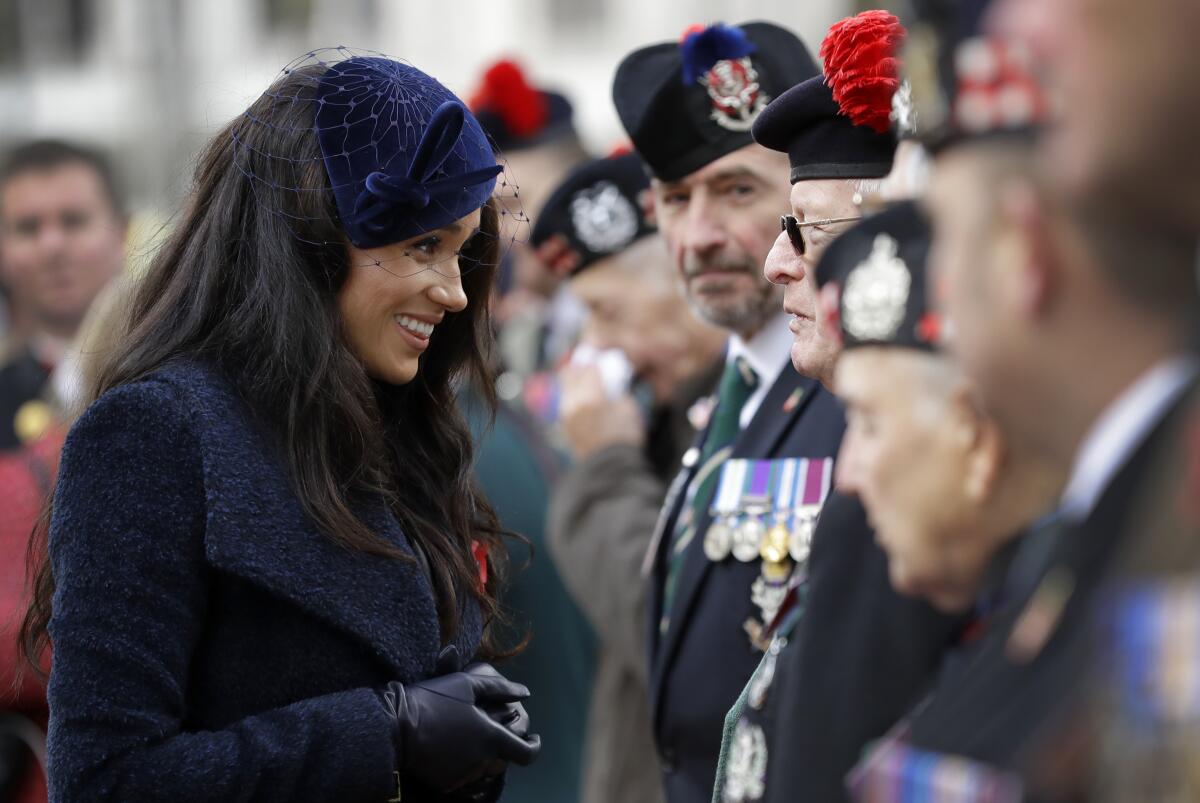Even in discordant times, a poignant national symbol endures in Britain. It’s small and red

- Share via
LONDON — In Britain, the poppies bloom in November.
Every late autumn, the artificial red blossoms appear without fail, fashioned from fabric or felt, enamel or plastic. They are affixed to the lapels of newscasters, the team uniforms of footballers, the rumpled raincoats of Tube passengers. Even the queen dons a scarlet poppy brooch.
The poppy pins are meant to commemorate military sacrifice in all the country’s wars. But they are most closely associated with a conflict whose wounds still linger more than a century after its end — World War I, when modern battlefield weapons met antiquated customs of warfare, to devastating effect.
Some three-quarters of a million British soldiers lost their lives in what was then called the Great War. Including combatants drawn from across the British Empire, the fatality figure rises to nearly 1 million.
“The First World War persists in our public mind-set and remains this kind of trauma,” said Laura Clouting, a senior curator at the Imperial War Museum in London who specializes in World War I. “The sheer numbers of men and women who died — for Britain, these losses were unprecedented and never matched since.”

Working-class recruits bore the brunt of the casualties in terms of total numbers. But wealthy, well-born young men — considered, in class-conscious Britain, to be the creme de la creme of society, destined for greatness — initially made up most of the field-officer corps and suffered disproportionate fatalities in horrific engagements such as the Battle of the Somme, in which 125,000 British service members died.
The poppy-wearing origin story is well known, stemming from a simple but shattering poem by a Canadian military doctor, John McCrae, who himself would die of meningitis before the war’s end. In 1915, struck by the presence of the hardy weed-like flowers springing from battlefield wastelands and rapidly expanding cemeteries on the Western Front, McCrae penned the lines known to generations of schoolchildren: “In Flanders fields the poppies blow/Between the crosses, row on row....”
The wearing of poppy pins is tied to Remembrance Day, commemorating the armistice between the Allies and Germany signed at 11 a.m. on Nov. 11, 1918 — famously, the eleventh hour of the eleventh day of the eleventh month. In cities and towns across Britain, as well as elsewhere in the Commonwealth, the proliferation of red lapel flowers becomes noticeable from around the end of October, with numbers swelling as the anniversary approaches.
Poppy pins take on a kind of Rorschach quality; some see wearing one as a way of honoring lives lost to history, while others see a glorification of conflict, especially the unpopular American-led wars in Iraq and Afghanistan, in which British troops played an important role. Instead of red artificial flowers, some wear white ones to symbolize hopes for peace.
Public figures who spurn the red poppy can face a backlash. In eight years of playing for several different English teams, soccer midfielder James McClean has refused to wear one, citing the actions of British troops in his Northern Ireland hometown of Londonderry. The city, also known as Derry, was the site of 1972’s “Bloody Sunday” killings, in which British paratroopers opened fire on protesters marching for civil rights for Roman Catholics. In all, 14 died.

This year’s Remembrance Day commemorations come at a polarizing moment. Britain is locked in acrimony over Brexit, the planned but so-far-stymied exit from the European Union.
Amid the angry debate, some see imperial nostalgia in hard-line Brexiters’ sloganeering imperative: “Take back control.” In 1914, when the Great War erupted, Britain was still a great power, presiding over a far-flung empire, though it emerged from the conflict bruised and battered.
“Brexit presses upon a lot of attitudes about what we aspire to, what we want our relationship with Europe and the rest of the world to be,” said Clouting. “So do poppies and other kinds of remembrance — we’re honoring those who died protecting our allies, and shared values.”
The annual distribution of poppy pins is largely spearheaded by a Royal British Legion charity, the Poppy Appeal, which supports veterans’ causes. Many Britons say making a small donation and picking up a poppy pin is a nod to family tradition, underpinned by half-remembered lore of long-ago suffering.
“I didn’t know my great-granddad, of course,” said Samantha Langham, harried from a day at her London sales office but pausing to drop a few one-pound coins into the tin at an appeal stand set up inside a supermarket. “But I do remember my grandfather telling me, when I was quite small, that when he was a boy my age, his own father came home from that war, and would never, ever talk about what happened over there.”
The poppy for a time was also a prominent symbol of World War I remembrance in the United States, largely thanks to the immense popularity of McCrae’s poem. But it eventually faded from view there — perhaps because for most Americans, the war lacked the wrenching firsthand impact experienced by virtually everyone in Britain.
The poppy’s role as public symbol may have reached its apotheosis in 2014, with a hugely successful public art installation at the Tower of London: nearly a million ceramic poppies set up in a moat.
Four years later, the centenary of the war’s end, the searing Peter Jackson film “They Shall Not Grow Old” used colorized images to bring the reality of trench warfare to life, spurring fresh public interest in the wartime lot of ordinary soldiers.
The 2018 commemorations were massive — and the poppy displays especially abundant. With no major anniversary, this year’s are smaller and more low-key. But Clouting doesn’t see the poppy tradition dying out any time soon.
“There’s this stark realization that there are no longer any living links to this war,” she said. “So we have to sort out all over again how to feel about it. Remembrance persists — as long as people want to remember.”
More to Read
Sign up for Essential California
The most important California stories and recommendations in your inbox every morning.
You may occasionally receive promotional content from the Los Angeles Times.












